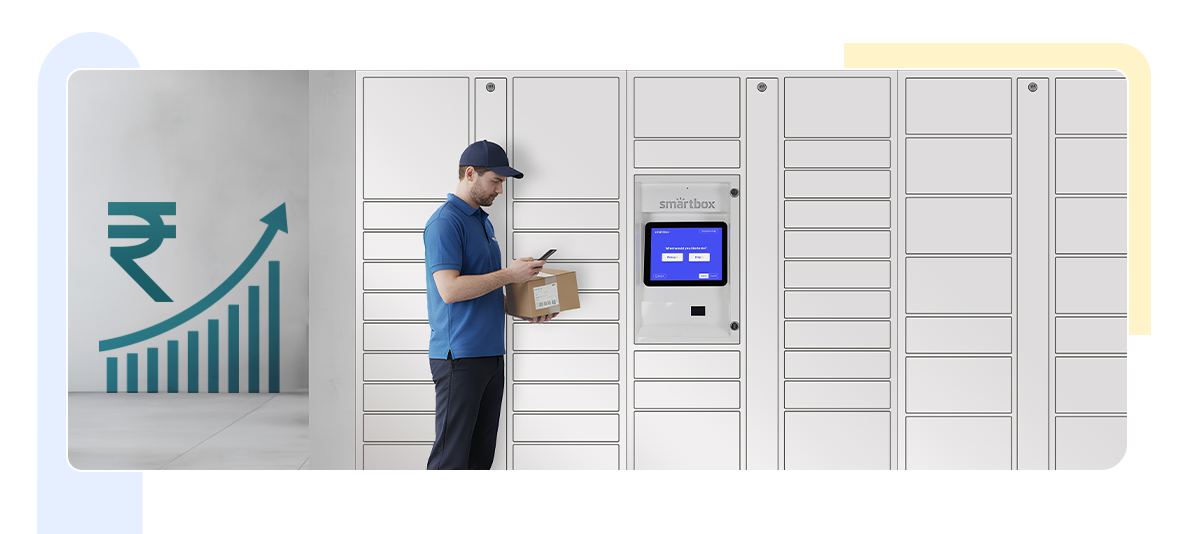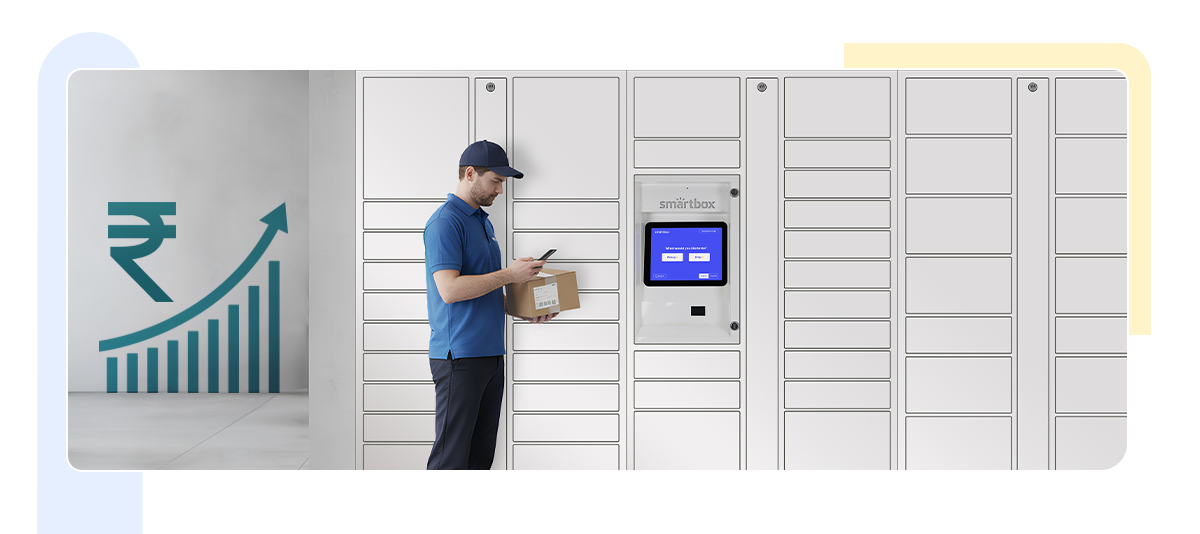The final leg of a product’s journey, the last mile is often the most expensive and complex part of the supply chain. For retailers, optimizing this stage is not just about cutting costs; it’s about unlocking new opportunities. Smart lockers are emerging as a key piece of last-mile infrastructure that can transform this challenge into a significant revenue generator.
This technology does more than just streamline click-and-collect services. When viewed as a strategic asset, a network of smart lockers can become a multifaceted revenue stream, enhancing customer loyalty and creating new business models. This post explores how retailers can monetize their last-mile locker infrastructure, turning a logistical necessity into a profitable venture.
Turning Last-Mile Costs into Revenue Centers
Traditionally, last-mile delivery is a cost center, consuming up to 53% of total shipping expenses. Failed deliveries, returns, and the demand for fast, free shipping put immense pressure on profit margins. Smart lockers offer a powerful solution by consolidating deliveries, reducing driver time, and eliminating the issue of missed drop-offs.
However, the real value lies in treating these lockers not just as cost-savers, but as revenue-generating assets. By leveraging your locker network, you can create new income streams while simultaneously boosting your core retail operations.
Direct Revenue Models
The most straightforward way to monetize smart lockers is by charging for their use. This can take several forms, each catering to different customer needs and business goals.
1. Premium or Subscription-Based Access
Offer customers premium access to your locker network for a fee. This model is similar to Amazon Prime, where a subscription provides benefits like unlimited, secure pickups from any locker in your network. You could also offer tiered plans, such as a basic free plan with limited access and a premium plan with features like extended holding times or access to refrigerated lockers for groceries.
2. Pay-Per-Use for Third Parties
Your smart locker network is a valuable asset that other businesses can use. Open up your infrastructure to other e-commerce companies, local businesses, or even individuals who need a secure drop-off and pickup point. This “Locker-as-a-Service” (LaaS) model turns your network into a public utility. You can charge a per-parcel fee, generating revenue from businesses that lack the scale to build their own locker network.
3. Fees for Extended Storage
While the goal is quick turnover, you can implement a fee structure for packages left in lockers beyond a standard free period (e.g., 48 hours). This not only encourages prompt collection, which frees up locker space, but also creates a small yet consistent revenue stream. This strategy is common in transportation hubs and has proven effective.
Indirect Revenue and Strategic Benefits
Beyond direct fees, smart lockers drive revenue indirectly by enhancing the customer experience and increasing foot traffic to your physical stores.
1. Driving In-Store Sales
Placing smart lockers inside or just outside your brick-and-mortar locations is a powerful strategy. When customers come to collect their online orders, they are already at your doorstep. This foot traffic presents a valuable opportunity for upselling and cross-selling. Research shows that a significant percentage of customers who use click-and-collect services make additional, unplanned purchases while in-store.
To maximize this effect, place lockers at the back of the store, guiding customers past enticing displays and promotional items. You can also send a targeted offer along with the pickup notification.
2. Enhancing Customer Loyalty and Lifetime Value
Convenience is a major driver of customer loyalty. A seamless, secure, and flexible pickup option improves the overall shopping experience. Happy customers are more likely to return, increasing their lifetime value (LTV). A study found that 65% of consumers are more likely to shop with a retailer that offers multiple delivery options. By providing a reliable smart locker service, you differentiate your brand and build a loyal customer base that translates directly to long-term revenue.
3. Advertising and Partnership Opportunities
The physical lockers and the digital interface (the screen on the locker bank) are prime real estate for advertising. You can sell this space to other brands, especially complementary ones. For example, a sporting goods retailer could feature ads for energy drinks or fitness apps. The revenue from these advertising partnerships can help offset the initial investment in the locker system and contribute to ongoing profitability.
Smart Locker Solutions for Housing Communities & Campuses – Reimagined with Smartbox Lockers
Smart locker technologies are fast becoming essential solutions for automated, secure, and 24/7 package management across housing communities and campuses. While many products exist, Smartbox Lockers consistently stand out due to their advanced integration, flexible scalability, robust security, and intelligent analytics – making them ideal for smart, future-ready properties.
Smart Locker Options – At a Glance
| Feature / Capability | Traditional Smart Locker Systems | Smart Package Rooms | Smartbox Lockers |
|---|---|---|---|
| Space & Scalability | Fixed compartments; overflow risk. | Flexible shelving; scalable with volume. | Modular, customizable lockers that adapt to any layout and scale with demand. |
| Package Handling | Best for standard parcels. | Handles oversized or irregular items. | Multiple configurations (standard, oversized, refrigerated). |
| Cost | High upfront installation costs. | Lower cost via room conversion. | Tailored solutions & flexible deployment – reduces unnecessary CAPEX. |
| Security | Compartment locks with entry logs. | Continuous monitoring, sensors. | Enterprise-grade security, encrypted codes, tracked access, and compliant with ISO standards. |
| Courier Workflow | Package-by-package locker placement. | Bulk drop‑offs on shelves. | Intelligent management simplifies courier drop‑offs, supports system integrations for automated workflows. |
| Installation Fit | Can struggle in legacy building spaces. | Easily fits many environments. | Custom designs for indoor/outdoor, retrofits, and constrained spaces. |
| Operational Analytics | Basic access logs. | Limited data insights. | Real‑time analytics & dashboard insights for usage, optimization, and ROI planning. |
Where Smartbox Lockers Shine in the Smart Locker Industry
1. Leader in Secure Smart Locker Technology
Smartbox is recognized as a leading smart locker provider with innovative, secure, and scalable automated systems tailored for residential communities, campuses, offices, and enterprises.
2. Customization & Modular Design
Unlike rigid systems, Smartbox lockers can be custom‑configured – from compartment sizes to layout and finish – making them ideal for diverse environments like apartment lobbies, university halls, and mailrooms.
3. Smart Software
Smartbox pairs hardware with powerful smart locker software that enables:
- Real‑time monitoring & analytics
- Remote management dashboards
- Dynamic notifications
- Secure data encryption and ISO‑compliance
4. Broad Use Cases Beyond Parcel Delivery
Smartbox expands utilization – not just for parcels but also for:
- IT asset management
- Retail lockers
- Refrigerated perishable pickup
- Academic resource exchanges
5. Operational Efficiency & ROI
Smartbox solutions are engineered to reduce manual labor, shorten delivery cycles, and boost satisfaction – turning lockers from a cost into a productivity and amenity asset for properties.
Key Benefits of Smartbox Lockers for Housing & Campus Use
Operational Efficiency
- Automates package sorting and retrieval.
- Reduces staff time spent on manual management.
- Integrates with courier workflows for fast drop‑offs.
Enhanced Resident/Student Experience
- 24/7 self‑service pickup with instant notifications.
- Seamless, secure access with dynamic access codes.
Security & Peace‑of‑Mind
- Tamper‑proof compartments.
- Encryption, real‑time tracking, and compliance standards.
Flexible Multi‑Use
- Parcel deliveries, equipment loans, library holds, and more – all from one smart infrastructure.
Smartbox Lockers are not just smart lockers – they are smart infrastructure built with the future in mind. With data-driven analytics, robust security, and flexible deployment options, Smartbox positions itself as a top choice for any community or campus aiming to modernize package and asset management.
Comparison Table: Delivery Alert Features For Smart Lockers And Alternatives
Smartbox Lockers revolutionize package retrieval with automated, real-time delivery alerts, offering a secure and efficient alternative to traditional delivery methods. Unlike manual or less secure systems such as home deliveries or manual mailrooms, Smartbox Lockers deliver immediate, multi-channel notifications, ensuring enhanced convenience and security for recipients.
Key Features of Smart Lockers
Smartbox Lockers provide an integrated and automated approach to delivery alerts, guaranteeing recipients are immediately notified upon package arrival. Below are the key features of Smartbox Lockers that distinguish them from traditional systems:
| Feature | Description |
|---|---|
| Instant Notification | Automated alerts are sent in real-time as soon as a courier deposits a package in the locker, ensuring immediate awareness. |
| Multi-Channel Delivery | Notifications are sent via multiple channels such as text message (SMS), email, ensuring the recipient receives timely updates. |
| Secure Access Codes | Each notification includes a unique, one-time PIN, QR code, or barcode that ensures only the intended recipient can access their package. |
| 24/7 Accessibility | Packages can be retrieved, and alerts can be received at any time, offering flexibility and convenience beyond traditional office hours. |
| Tracking & Logging | Real-time tracking and an automated audit trail log every event, providing transparency and security for both recipients and property managers. |
| Staggered Notifications | To prevent crowding during peak hours, some systems offer staggered delivery notifications, improving the flow and reducing wait times. |
Comparison with Alternative Delivery Systems
Unlike Smartbox Lockers, alternative delivery methods often lack automation, real-time notifications, and security. The table below highlights the limitations of these alternatives:
| Alternative | Delivery Alert Features & Limitations |
|---|---|
| Home/Doorstep Delivery | Carrier apps/websites provide tracking and estimated delivery windows.- No secure “arrived” alert; vulnerable to “porch piracy”.- Reliance on signature or “delivered” status, often without specific location details. |
| Manual Mailroom/Office Staff | Property staff manually sort, log, and notify recipients.- Delayed notifications due to reliance on staff availability.- Restricted access hours, unlike the 24/7 access of Smartbox Lockers. |
| Traditional Lockers/Open Shelves | No automated notification system.- Recipients must physically check lockers or shelves.- Increased security risks as there are no access controls, making packages vulnerable to theft. |
Smartbox Lockers offer a clear advantage over alternative delivery methods by providing instant, secure, and automated alerts. This system ensures packages are promptly retrieved with minimal administrative effort, addressing common inefficiencies and security risks found in traditional delivery systems.
Innovative Monetization Strategies
As the smart locker ecosystem matures, retailers are finding even more creative ways to generate revenue.
Reverse Logistics and Returns Management
Managing returns is a costly headache for retailers. Smart lockers can streamline this process, making it easier for customers and more efficient for your operations. By allowing customers to drop off returns at a locker, you consolidate returned items at specific locations, reducing shipping costs and processing time.
You can monetize this by offering the service to other retailers for a fee. Your locker network becomes a shared returns hub, creating another B2B revenue stream. This simplifies logistics for smaller brands and provides a valuable service that generates income for you.
Hyperlocal Fulfillment and Gig Economy Integration
Smart lockers can function as mini warehouses for hyperlocal fulfillment. Stock high-demand items directly in lockers located in strategic residential or commercial areas. Customers can purchase and receive these items almost instantly. This model is particularly effective for consumer-packaged goods (CPG), electronics, or even hot food.
Furthermore, you can integrate your locker network with gig economy delivery services. A delivery driver could pick up multiple orders from a single locker location instead of traveling to a large, out-of-the-way distribution center. You can charge a small fee to the delivery platform for this access, optimizing their operations while monetizing your infrastructure.
Potential Challenges and How to Overcome Them
While the opportunities are significant, implementing a smart locker strategy comes with challenges.
- Initial Investment: The upfront cost of hardware, software, and installation can be substantial.
Solution: Start with a pilot program in a few high-traffic locations to prove the ROI. Explore leasing options or partner with a locker network provider to reduce the initial capital expenditure.
- Location and Accessibility: The success of a locker network depends heavily on its placement.
Solution: Use data analytics to identify optimal locations, such as busy transit hubs, residential complexes, and your own high-performing stores. Ensure lockers are accessible 24/7 and comply with disability access regulations.
- Technology Integration: The locker software must integrate seamlessly with your e-commerce platform, inventory management system, and customer communication tools.
Solution: Work with technology partners who offer robust APIs and proven integration capabilities. A smooth, glitch-free user experience is critical for adoption.
Spotlight on Smartbox: Elevating Last-Mile Monetization
One standout solution in the smart locker arena is Smartbox—a platform designed to maximize both operational efficiency and revenue potential for retailers. Smartbox offers modular, customizable lockers that seamlessly integrate with existing retail technology. Compatible with most e-commerce platforms and payment gateways, Smartbox ensures smooth transactions and real-time notifications for users.
Key Features and Benefits
- Advanced Security: Each Smartbox unit uses robust locking mechanisms and user verification methods, providing peace of mind for both retailers and consumers.
- Flexible Configurations: Modular design means lockers can be tailored to fit retail space, traffic demands, and specialized needs such as temperature control for groceries or pharmaceuticals.
- Data Analytics and Insights: Smartbox includes analytics tools that track usage patterns, pickup times, and storage durations. Retailers can leverage these insights to optimize locker locations, pricing strategies, and cross-selling opportunities.
The Future is Automated and Profitable
Smart lockers represent a fundamental shift in how retailers approach last-mile logistics. By moving from a cost-centric to a revenue-centric mindset, you can transform this infrastructure into a powerful engine for growth. Whether through direct fees, increased in-store sales, or innovative B2B services, smart lockers offer a clear path to monetizing the final step of the customer’s journey.
The key is to view your locker network not just as a set of steel boxes, but as a strategic platform. It’s a customer touchpoint, a marketing channel, a logistical hub, and a new frontier for retail revenue. By embracing this technology, you can build a more efficient, customer-friendly, and profitable business.
























